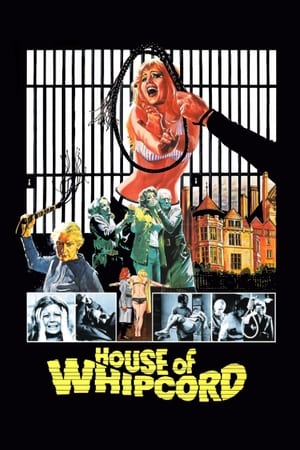
House of Whipcord
I’ve always thought that this film was going to be one of those seedy, underground 1970s sexploitation films with no plot and lots of naked women being whipped left right and centre. However, I’m pleased to say that while it is low budget, with the odd flash of unnecessary flesh it is also quite a reasonable little horror that at times can be quiet harrowing. Made by independent producer and director Pete Walker, it is the first of a trilogy of horror/thrillers that he made with writer David McGillivray during the 1970s. Classed as a WIP (Women In Prison) film, it is definitely a film with a message, beginning with the moral comment ‘This film is dedicated to those that are disturbed by lax moral codes of today, and those who eagerly await the return of corporal and capital punishment’. Walker has claimed that he shot the film to rub people up the wrong way, but that he wasn’t wholly happy with the amount of nudity in the film at the time. Remembering all this, it is actually quite a cleverly written British shocker that is very representative of the time it was made. The film begins with dark shots, which make it quite tricky to see what is going on. This actually is a very effective way of making the viewer immediately uncomfortable. Who is this man sitting in a truck? What has happened to the girl, and more importantly what WILL happen to the girl? Both titles and sound track are typical of other horrors of the period and we then settle in to a swinging ’70s get together, where we meet Ann-Marie Di Verney (Penny Irving – ’70s ‘Page 3′ girl) a 19 year old French glamour model, all alone in London to make her fame and fortune. Ann-Marie is upset by the unveiling of her topless photograph at the party and retreats to the back of the room where she meets a mysterious stranger. Our next introduction is to Ann-Marie’s flat mate, Julia, played by Ann Michelle (sister to Vicki, who played Yvette in 80s TV comedy ”Allo, ‘Allo’), who helps Ann-Marie to get ready for her evening out with the handsome Mark De Sade (yes, you read that correctly), and of course you don’t wear clothes when you come out of the shower! At a fashionable ’70s restaurant we begin to realise that Mark (Robert Tayman of Vampire Circus) is not totally the full ticket, and when he invites Ann-Marie to meet his family at the weekend we just know that this isn’t a good idea, so obviously she accepts his invitation. The film then seems to make a conscious decision to use light to separate scenes that are dark, featureless and disturbing with those of the colourful, fashionable and calming respites, as we cut between the House of Correction and the normal outside world. Mark takes Ann-Marie to meet his family, and sweet, innocent Ann-Marie becomes unnerved by her new friend’s aloofness and erratic driving, but not so much that she cannot sleep on the journey. On entering the gates we know that something is not quite right, and when Mark leaves her on the doorstep, Ann-Marie still doesn’t seem to notice that there could be a problem. However, with the return of the darkness on screen the audience knows that something is up, and Ann-Marie’s nightmares begin as she is led into the prison. The prison scenes were set and filmed in Little Dean Jail, which still stands in The Forest of Dean, Gloucestershire, and by using a real prison Walker offers us a genuine insight into life inside the detention centre, narrow corridors and sparse decoration add to the uneasiness of the film, no fake sets here! We meet the wardens, two drab unsavoury women who we later find out have worked together for years, totally absorbed in the belief that their behaviour towards the inmates is totally justified. We find that Mark’s mother, Margaret Wakehurst (Barbara Markham) and blind father, Judge Bailey (Patrick Barr, actually the son of a judge) have taken it upon themselves to create a House of Correction, where they can administer proper sentences to young woman who’s criminal prosecutions in the outside world where deemed too lenient in their eyes. We learn about the hardships of the girls interred within the walls of this private prison, and the three chance rule which can and ultimately does lead to their demise. The actress Sheila Keith comes to her own in her role as chief warden, Walker. Keith has an uncanny air about her, you know she means business, you know she is unhinged, and you know that she wouldn’t think twice about murdering her charges. Prolific on British TV screens throughout the 1960s, ’70s, ’80s and ’90s, she went on to play leading roles in three other of Pete Walker’s films; Frightmare (1974), The Comeback (1978) and The House of Long Shadows (1983). Tension starts to build when we realise that it is Ann-Marie that the lorry driver has in his cab after her bid to escape. In his urgency to help her he inadvertently ends up returning her to the prison, and this puts the audience on the edge of their seat as they watch helplessly as the story unfolds. I wanted to shout out “No! No! Don’t go in there!” several times, and I loved the character of Mr Kind (yes, you read that correctly) who through his concern for Ann-Marie ultimately saves the day, well almost! The last part of the film definitely keeps the viewer guessing, will they wont they? You really can’t tell what is going to happen and its very cleverly put together as it cuts from prison to countryside. Needless to say, there are not many survivors by the time the end credits roll, and the judges final words only go to confirm that the family where as nutty as a fruit cake. Overall, I was impressed with this little gem of a horror film. Today, the small about of nudity doesn’t detract from the storyline and we never actually see the women being flogged, just hear the screams echo through the screen to leave that to the imagination. On the whole the acting was good, only Ann-Marie’s French accent lets it down. I’m now hunting down Pete Walker’s other offerings, as I definitely think I could become a fan!
